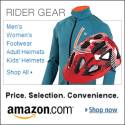Here’s a story from Wichita, Kansas about how a bicycle helmet might have saved a lot of heartache:
Steven Darrow was a promising young graphic artist who had worked on high-profile projects and held successful art shows at Final Friday.
He was “just on the cusp of a fabulous career,” said Michele Benefiel Guiol, his mother.
That all changed one night last summer.
Darrow, 23, was “messing around” on his bicycle with a group of friends next to the old Cox Building on Douglas next to the railroad overpass, she said.
Darrow couldn’t afford a car, so he rode his bicycle everywhere.
He and his friends were swerving in and out of pillars after sunset on July 25 when Darrow slammed into one. He fell backward, breaking his right clavicle and fracturing his skull in several places.
He wasn’t wearing a helmet.
“He was an avid bicyclist, but he wasn’t a safe bicyclist,” Benefiel Guiol said. “He never wore a helmet.”
Read more from The Wichita Eagle: Wichita family advocates bike helmets after man’s accident
We can debate the merits of that last statement (there’s far more involved in safety than just helmet use), and there’s no guarantee that the outcome would have been any different if he’d been wearing a helmet, but it’s pretty clear that this type of accident — the low-speed impact of a fragile head against an immovable object — is exactly the type of incident in which a helmet can be most useful.
According to the Bicycle Helmet Safety Institute, “A very high percentage of cyclists’ brain injuries can be prevented by a helmet, estimated by different studies at anywhere from 45 to 88 per cent.”
And incidentally, you don’t necessarily need to spend a lot of money to adequate protection. The Bicycle Helmet Safety Institute found that Cheap helmets and expensive helmets perform equally in impacts: “When you pay more for a helmet you may get an easier fit, more vents and snazzier graphics. But the basic impact protection of the cheap helmets tested equaled the expensive ones.”
In Wichita, Steven Darrow is now back home with his family, but he’ll never be the same. Part of the frontal lobe of his brain had to be removed to save his life. He’s “had to learn to do everything all over again: walk, eat, handle basic tasks. He now lives with his parents, able to answer questions but unable to carry on a conversation.”
His mother hopes to use Darrow’s accident to increase awareness about the value of bicycle helmets, and hopes eventurally to start a company that manufactures bicycle helmets with Darrow’s artwork on them. “We’re trying to find something good from this,” she said.
For adults, use of bicycle helmets is a personal choice. For myself, I see very few reasons not to wear a helmet.
What about you?
See also: Injury-Control Recommendations: Bicycle Helmets from the Centers for Disease Control and Prevention, and Demonstrating Bicycle Helmet Effectiveness: A How-to Guide (PDF) from the National Highway Traffic Safety Administration.
Post tags: Wichita


